Fruit

Culinary fruits

A large variety of fruits displayed at a market

The Medici citrus collection by Bartolomeo Bimbi, 1715
In botany, a fruit is the seed-bearing structure in flowering plants (also known as angiosperms) formed from the ovary after flowering.
Fruits are the means by which angiosperms disseminate seeds. Edible fruits, in particular, have propagated with the movements of humans and animals in a symbiotic relationship as a means for seed dispersal and nutrition; in fact, humans and many animals have become dependent on fruits as a source of food.[1] Accordingly, fruits account for a substantial fraction of the world's agricultural output, and some (such as the apple and the pomegranate) have acquired extensive cultural and symbolic meanings.
In common language usage, "fruit" normally means the fleshy seed-associated structures of a plant that are sweet or sour, and edible in the raw state, such as apples, bananas, grapes, lemons, oranges, and strawberries. On the other hand, in botanical usage, "fruit" includes many structures that are not commonly called "fruits", such as bean pods, corn kernels, tomatoes, and wheat grains.[2][3] The section of a fungus that produces spores is also called a fruiting body.[4]
Contents
1 Botanic fruit and culinary fruit
2 Structure
3 Development
3.1 Simple fruit
3.2 Aggregate fruit
3.3 Multiple fruits
3.4 Berries
3.5 Accessory fruit
3.6 Table of fruit examples
4 Seedless fruits
5 Seed dissemination
6 Uses
6.1 Nutritional value
6.2 Nonfood uses
7 Safety
8 Allergies
9 Storage
10 See also
11 References
12 Further reading
13 External links
Botanic fruit and culinary fruit

Venn diagram representing the relationship between (culinary) vegetables and botanical fruits[citation needed]
Many common terms for seeds and fruit do not correspond to the botanical classifications. In culinary terminology, a fruit is usually any sweet-tasting plant part, especially a botanical fruit; a nut is any hard, oily, and shelled plant product; and a vegetable is any savory or less sweet plant product.[5] However, in botany, a fruit is the ripened ovary or carpel that contains seeds, a nut is a type of fruit and not a seed, and a seed is a ripened ovule.[6]
Examples of culinary "vegetables" and nuts that are botanically fruit include corn, cucurbits (e.g., cucumber, pumpkin, and squash), eggplant, legumes (beans, peanuts, and peas), sweet pepper, and tomato. In addition, some spices, such as allspice and chili pepper, are fruits, botanically speaking.[6] In contrast, rhubarb is often referred to as a fruit, because it is used to make sweet desserts such as pies, though only the petiole (leaf stalk) of the rhubarb plant is edible,[7] and edible gymnosperm seeds are often given fruit names, e.g., ginkgo nuts and pine nuts.
Botanically, a cereal grain, such as corn, rice, or wheat, is also a kind of fruit, termed a caryopsis. However, the fruit wall is very thin and is fused to the seed coat, so almost all of the edible grain is actually a seed.[8]
Structure
The outer, often edible layer, is the pericarp, formed from the ovary and surrounding the seeds, although in some species other tissues contribute to or form the edible portion. The pericarp may be described in three layers from outer to inner, the epicarp, mesocarp and endocarp.
Fruit that bears a prominent pointed terminal projection is said to be beaked.[9]
Development
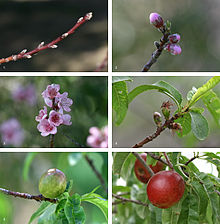
The development sequence of a typical drupe, the nectarine (Prunus persica) over a 7.5 month period, from bud formation in early winter to fruit ripening in midsummer (see image page for further information)
A fruit results from maturation of one or more flowers, and the gynoecium of the flower(s) forms all or part of the fruit.[10]
Inside the ovary/ovaries are one or more ovules where the megagametophyte contains the egg cell.[11] After double fertilization, these ovules will become seeds. The ovules are fertilized in a process that starts with pollination, which involves the movement of pollen from the stamens to the stigma of flowers. After pollination, a tube grows from the pollen through the stigma into the ovary to the ovule and two sperm are transferred from the pollen to the megagametophyte. Within the megagametophyte one of the two sperm unites with the egg, forming a zygote, and the second sperm enters the central cell forming the endosperm mother cell, which completes the double fertilization process.[12][13] Later the zygote will give rise to the embryo of the seed, and the endosperm mother cell will give rise to endosperm, a nutritive tissue used by the embryo.
As the ovules develop into seeds, the ovary begins to ripen and the ovary wall, the pericarp, may become fleshy (as in berries or drupes), or form a hard outer covering (as in nuts). In some multiseeded fruits, the extent to which the flesh develops is proportional to the number of fertilized ovules.[14] The pericarp is often differentiated into two or three distinct layers called the exocarp (outer layer, also called epicarp), mesocarp (middle layer), and endocarp (inner layer). In some fruits, especially simple fruits derived from an inferior ovary, other parts of the flower (such as the floral tube, including the petals, sepals, and stamens), fuse with the ovary and ripen with it. In other cases, the sepals, petals and/or stamens and style of the flower fall off. When such other floral parts are a significant part of the fruit, it is called an accessory fruit. Since other parts of the flower may contribute to the structure of the fruit, it is important to study flower structure to understand how a particular fruit forms.[3]
There are three general modes of fruit development:
- Apocarpous fruits develop from a single flower having one or more separate carpels, and they are the simplest fruits.
- Syncarpous fruits develop from a single gynoecium having two or more carpels fused together.
- Multiple fruits form from many different flowers.
Plant scientists have grouped fruits into three main groups, simple fruits, aggregate fruits, and composite or multiple fruits.[15] The groupings are not evolutionarily relevant, since many diverse plant taxa may be in the same group, but reflect how the flower organs are arranged and how the fruits develop.
Simple fruit
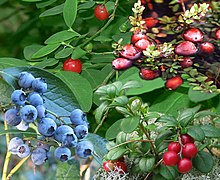
Epigynous berries are simple fleshy fruit. Clockwise from top right: cranberries, lingonberries, blueberries, red huckleberries
Simple fruits can be either dry or fleshy, and result from the ripening of a simple or compound ovary in a flower with only one pistil. Dry fruits may be either dehiscent (they open to discharge seeds), or indehiscent (they do not open to discharge seeds).[16] Types of dry, simple fruits, and examples of each, include:
achene – Most commonly seen in aggregate fruits (e.g., strawberry)
capsule – (e.g., Brazil nut)
caryopsis – (e.g., wheat)
cypsela – an achene-like fruit derived from the individual florets in a capitulum (e.g., dandelion).
fibrous drupe – (e.g., coconut, walnut)
follicle – is formed from a single carpel, opens by one suture (e.g., milkweed), commonly seen in aggregate fruits (e.g., magnolia)
legume – (e.g., bean, pea, peanut)
loment – a type of indehiscent legume
nut – (e.g., beech, hazelnut, oak acorn)
samara – (e.g., ash, elm, maple key)
schizocarp – (e.g., carrot seed)
silique – (e.g., radish seed)
silicle – (e.g., shepherd's purse)
utricle – (e.g., beet)
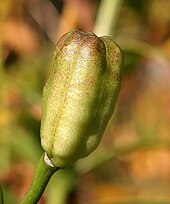
Lilium unripe capsule fruit
Fruits in which part or all of the pericarp (fruit wall) is fleshy at maturity are simple fleshy fruits. Types of simple, fleshy, fruits (with examples) include:
berry – (e.g., cranberry, gooseberry, redcurrant, tomato)- stone fruit or drupe (e.g., apricot, cherry, olive, peach, plum)
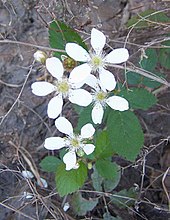
Dewberry flowers. Note the multiple pistils, each of which will produce a drupelet. Each flower will become a blackberry-like aggregate fruit.
An aggregate fruit, or etaerio, develops from a single flower with numerous simple pistils.[17]
Magnolia and peony, collection of follicles developing from one flower.
Sweet gum, collection of capsules.
Sycamore, collection of achenes.
Teasel, collection of cypsellas
Tuliptree, collection of samaras.
The pome fruits of the family Rosaceae, (including apples, pears, rosehips, and saskatoon berry) are a syncarpous fleshy fruit, a simple fruit, developing from a half-inferior ovary.[18]
Schizocarp fruits form from a syncarpous ovary and do not really dehisce, but rather split into segments with one or more seeds; they include a number of different forms from a wide range of families.[15] Carrot seed is an example.
Aggregate fruit

Detail of raspberry flower
Aggregate fruits form from single flowers that have multiple carpels which are not joined together, i.e. each pistil contains one carpel. Each pistil forms a fruitlet, and collectively the fruitlets are called an etaerio. Four types of aggregate fruits include etaerios of achenes, follicles, drupelets, and berries. Ranunculaceae species, including Clematis and Ranunculus have an etaerio of achenes, Calotropis has an etaerio of follicles, and Rubus species like raspberry, have an etaerio of drupelets. Annona have an etaerio of berries.[19][20]
The raspberry, whose pistils are termed drupelets because each is like a small drupe attached to the receptacle. In some bramble fruits (such as blackberry) the receptacle is elongated and part of the ripe fruit, making the blackberry an aggregate-accessory fruit.[21] The strawberry is also an aggregate-accessory fruit, only one in which the seeds are contained in achenes.[22] In all these examples, the fruit develops from a single flower with numerous pistils.
Multiple fruits
A multiple fruit is one formed from a cluster of flowers (called an inflorescence). Each flower produces a fruit, but these mature into a single mass.[23] Examples are the pineapple, fig, mulberry, osage-orange, and breadfruit.

In some plants, such as this noni, flowers are produced regularly along the stem and it is possible to see together examples of flowering, fruit development, and fruit ripening.
In the photograph on the right, stages of flowering and fruit development in the noni or Indian mulberry (Morinda citrifolia) can be observed on a single branch. First an inflorescence of white flowers called a head is produced. After fertilization, each flower develops into a drupe, and as the drupes expand, they become connate (merge) into a multiple fleshy fruit called a syncarp.
Berries
Berries are another type of fleshy fruit; they are simple fruit created from a single ovary.[24] The ovary may be compound, with several carpels. Types include (examples follow in the table below):
Pepo – berries whose skin is hardened, cucurbits
Hesperidium – berries with a rind and a juicy interior, like most citrus fruit
Accessory fruit
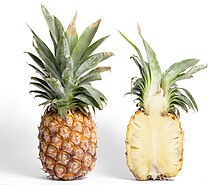
The fruit of a pineapple includes tissue from the sepals as well as the pistils of many flowers. It is an accessory fruit and a multiple fruit.
Some or all of the edible part of accessory fruit is not generated by the ovary. Accessory fruit can be simple, aggregate, or multiple, i.e., they can include one or more pistils and other parts from the same flower, or the pistils and other parts of many flowers.
Table of fruit examples
| True berry | Pepo | Hesperidium | Aggregate fruit | Multiple fruit | Accessory fruit |
|---|---|---|---|---|---|
Blackcurrant, Blueberry, Chili pepper, Cranberry, Eggplant, Gooseberry, Grape, Guava, Kiwifruit, Lucuma, Pomegranate, Redcurrant, Tomato | Cucumber, Gourd, Melon, Pumpkin | Grapefruit, Lemon, Lime, Orange | Blackberry, Boysenberry, Raspberry | Fig, Hedge apple, Mulberry, Pineapple | Apple, Pineapple, Rose hip, Stone fruit, Strawberry |
Seedless fruits

Some seedless fruits

An arrangement of fruits commonly thought of as vegetables, including tomatoes and various squash
Seedlessness is an important feature of some fruits of commerce. Commercial cultivars of bananas and pineapples are examples of seedless fruits. Some cultivars of citrus fruits (especially grapefruit, mandarin oranges, navel oranges), satsumas, table grapes, and watermelons are valued for their seedlessness. In some species, seedlessness is the result of parthenocarpy, where fruits set without fertilization. Parthenocarpic fruit set may or may not require pollination, but most seedless citrus fruits require a stimulus from pollination to produce fruit.
Seedless bananas and grapes are triploids, and seedlessness results from the abortion of the embryonic plant that is produced by fertilization, a phenomenon known as stenospermocarpy, which requires normal pollination and fertilization.[25]
Seed dissemination
Variations in fruit structures largely depend on their seeds' mode of dispersal. This dispersal can be achieved by animals, explosive dehiscence, water, or wind.[26]
Some fruits have coats covered with spikes or hooked burrs, either to prevent themselves from being eaten by animals, or to stick to the feathers, hairs, or legs of animals, using them as dispersal agents. Examples include cocklebur and unicorn plant.[27][28]
The sweet flesh of many fruits is "deliberately" appealing to animals, so that the seeds held within are eaten and "unwittingly" carried away and deposited (i.e., defecated) at a distance from the parent. Likewise, the nutritious, oily kernels of nuts are appealing to rodents (such as squirrels), which hoard them in the soil to avoid starving during the winter, thus giving those seeds that remain uneaten the chance to germinate and grow into a new plant away from their parent.[6]
Other fruits are elongated and flattened out naturally, and so become thin, like wings or helicopter blades, e.g., elm, maple, and tuliptree. This is an evolutionary mechanism to increase dispersal distance away from the parent, via wind. Other wind-dispersed fruit have tiny "parachutes", e.g., dandelion, milkweed, salsify.[26]
Coconut fruits can float thousands of miles in the ocean to spread seeds. Some other fruits that can disperse via water are nipa palm and screw pine.[26]
Some fruits fling seeds substantial distances (up to 100 m in sandbox tree) via explosive dehiscence or other mechanisms, e.g., impatiens and squirting cucumber.[29]
Uses

Nectarines are one of many fruits that can be easily stewed.
Many hundreds of fruits, including fleshy fruits (like apple, kiwifruit, mango, peach, pear, and watermelon) are commercially valuable as human food, eaten both fresh and as jams, marmalade and other preserves. Fruits are also used in manufactured foods (e.g., cakes, cookies, ice cream, muffins, or yogurt) or beverages, such as fruit juices (e.g., apple juice, grape juice, or orange juice) or alcoholic beverages (e.g., brandy, fruit beer, or wine).[30] Fruits are also used for gift giving, e.g., in the form of Fruit Baskets and Fruit Bouquets.
Many "vegetables" in culinary parlance are botanical fruits, including bell pepper, cucumber, eggplant, green bean, okra, pumpkin, squash, tomato, and zucchini.[31]Olive fruit is pressed for olive oil. Spices like allspice, black pepper, paprika, and vanilla are derived from berries.[32]
Nutritional value
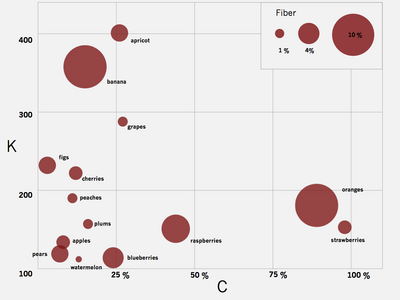
Each point refers to a 100 g serving of the fresh fruit, the daily recommended allowance of vitamin C is on the X axis and mg of Potassium (K) on the Y (offset by 100 mg which every fruit has) and the size of the disk represents amount of fiber (key in upper right). Watermelon, which has almost no fiber, and low levels of vitamin C and potassium, comes in last place.
Fresh fruits are generally high in fiber, vitamin C, and water.[33]
Regular consumption of fruit is generally associated with reduced risks of several diseases and functional declines associated with aging.[34][35]
Nonfood uses
Because fruits have been such a major part of the human diet, various cultures have developed many different uses for fruits they do not depend on for food. For example:
Bayberry fruits provide a wax often used to make candles;[36]
- Many dry fruits are used as decorations or in dried flower arrangements (e.g., annual honesty, cotoneaster, lotus, milkweed, unicorn plant, and wheat). Ornamental trees and shrubs are often cultivated for their colorful fruits, including beautyberry, cotoneaster, holly, pyracantha, skimmia, and viburnum.[37]
- Fruits of opium poppy are the source of opium, which contains the drugs codeine and morphine, as well as the biologically inactive chemical theabaine from which the drug oxycodone is synthesized.[38]
Osage orange fruits are used to repel cockroaches.[39]
- Many fruits provide natural dyes (e.g., cherry, mulberry, sumac, and walnut).[40]
- Dried gourds are used as bird houses, cups, decorations, dishes, musical instruments, and water jugs.
Pumpkins are carved into Jack-o'-lanterns for Halloween.- The spiny fruit of burdock or cocklebur inspired the invention of Velcro.[41]
Coir fiber from coconut shells is used for brushes, doormats, floor tiles, insulation, mattresses, sacking, and as a growing medium for container plants. The shell of the coconut fruit is used to make bird houses, bowls, cups, musical instruments, and souvenir heads.[42]
- Fruit is often a subject of still life paintings.
Safety
For food safety, the CDC recommends proper fruit handling and preparation to reduce the risk of food contamination and foodborne illness. Fresh fruits and vegetables should be carefully selected; at the store, they should not be damaged or bruised; and precut pieces should be refrigerated or surrounded by ice.
All fruits and vegetables should be rinsed before eating. This recommendation also applies to produce with rinds or skins that are not eaten. It should be done just before preparing or eating to avoid premature spoilage.
Fruits and vegetables should be kept separate from raw foods like meat, poultry, and seafood, as well as from utensils that have come in contact with raw foods. Fruits and vegetables that are not going to be cooked should be thrown away if they have touched raw meat, poultry, seafood, or eggs.
All cut, peeled, or cooked fruits and vegetables should be refrigerated within two hours. After a certain time, harmful bacteria may grow on them and increase the risk of foodborne illness.[43]
Allergies
Fruit allergies make up about 10 percent of all food related allergies.[44][45]
Storage
All fruits benefit from proper post harvest care, and in many fruits, the plant hormone ethylene causes ripening. Therefore, maintaining most fruits in an efficient cold chain is optimal for post harvest storage, with the aim of extending and ensuring shelf life.[46]
See also
- Fruit tree
- Fruitarianism
- List of culinary fruits
- List of foods
- List of fruit dishes
References
^ Lewis, Robert A. (January 1, 2002). CRC Dictionary of Agricultural Sciences. CRC Press. ISBN 0-8493-2327-4..mw-parser-output cite.citation{font-style:inherit}.mw-parser-output q{quotes:"""""""'""'"}.mw-parser-output code.cs1-code{color:inherit;background:inherit;border:inherit;padding:inherit}.mw-parser-output .cs1-lock-free a{background:url("//upload.wikimedia.org/wikipedia/commons/thumb/6/65/Lock-green.svg/9px-Lock-green.svg.png")no-repeat;background-position:right .1em center}.mw-parser-output .cs1-lock-limited a,.mw-parser-output .cs1-lock-registration a{background:url("//upload.wikimedia.org/wikipedia/commons/thumb/d/d6/Lock-gray-alt-2.svg/9px-Lock-gray-alt-2.svg.png")no-repeat;background-position:right .1em center}.mw-parser-output .cs1-lock-subscription a{background:url("//upload.wikimedia.org/wikipedia/commons/thumb/a/aa/Lock-red-alt-2.svg/9px-Lock-red-alt-2.svg.png")no-repeat;background-position:right .1em center}.mw-parser-output .cs1-subscription,.mw-parser-output .cs1-registration{color:#555}.mw-parser-output .cs1-subscription span,.mw-parser-output .cs1-registration span{border-bottom:1px dotted;cursor:help}.mw-parser-output .cs1-hidden-error{display:none;font-size:100%}.mw-parser-output .cs1-visible-error{font-size:100%}.mw-parser-output .cs1-subscription,.mw-parser-output .cs1-registration,.mw-parser-output .cs1-format{font-size:95%}.mw-parser-output .cs1-kern-left,.mw-parser-output .cs1-kern-wl-left{padding-left:0.2em}.mw-parser-output .cs1-kern-right,.mw-parser-output .cs1-kern-wl-right{padding-right:0.2em}
^ Schlegel, Rolf H J (January 1, 2003). Encyclopedic Dictionary of Plant Breeding and Related Subjects. Haworth Press. p. 177. ISBN 1-56022-950-0.
^ ab Mauseth, James D. (April 1, 2003). Botany: An Introduction to Plant Biology. Jones and Bartlett. pp. 271–272. ISBN 0-7637-2134-4.
^ "Sporophore from Encyclopædia Britannica". Archived from the original on 2011-02-22.
^ For a Supreme Court of the United States ruling on the matter, see Nix v. Hedden.
^ abc McGee, Harold (November 16, 2004). On Food and Cooking: The Science and Lore of the Kitchen. Simon & Schuster. pp. 247–248. ISBN 0-684-80001-2.
^ McGee (2004-11-16). On Food and Cooking. p. 367. ISBN 978-0-684-80001-1.
^ Lewis (2002). CRC Dictionary of Agricultural Sciences. p. 238. ISBN 978-0-8493-2327-0.
^ "Glossary of Botanical Terms". FloraBase. Western Australian Herbarium. Archived from the original on 8 October 2014. Retrieved 23 July 2014.
^ Esau, K. 1977. Anatomy of seed plants. John Wiley and Sons, New York.
^ [1] Archived December 20, 2010, at the Wayback Machine.
^ Mauseth, James D. (2003). Botany: an introduction to plant biology. Boston: Jones and Bartlett Publishers. p. 258. ISBN 978-0-7637-2134-3.
^ Rost, Thomas L.; Weier, T. Elliot; Weier, Thomas Elliot (1979). Botany: a brief introduction to plant biology. New York: Wiley. pp. 135–37. ISBN 0-471-02114-8.
^ Mauseth (2003-04-25). Botany. Chapter 9: Flowers and Reproduction. ISBN 978-0-7637-2134-3.
^ ab Singh, Gurcharan (2004). Plants Systematics: An Integrated Approach. Science Publishers. p. 83. ISBN 1-57808-351-6.
^ Schlegel (2003-05-13). Encyclopedic Dictionary. p. 123. ISBN 978-1-56022-950-6.
^ Schlegel (2003-05-13). Encyclopedic Dictionary. p. 16. ISBN 978-1-56022-950-6.
^ Evolutionary trends in flowering plants. New York: Columbia University Press. 1991. p. 209. ISBN 0-231-07328-3.
^ Gupta, Prof. P.K. (2007). Genetics Classical To Modern. Rastogi Publication. pp. 2–134. ISBN 978-81-7133-896-2.
^ http://www.rkv.rgukt.in/content/Biology/47Module/47fruit.pdf[permanent dead link]
^ McGee (2004-11-16). On Food and Cooking. pp. 361–362. ISBN 978-0-684-80001-1.
^ McGee (2004-11-16). On Food and Cooking. pp. 364–365. ISBN 978-0-684-80001-1.
^ Schlegel (2003-05-13). Encyclopedic Dictionary. p. 282. ISBN 978-1-56022-950-6.
^ Sinha, Nirmal; Sidhu, Jiwan; Barta, Jozsef; Wu, James; Cano, M. Pilar (2012-06-20). Handbook of Fruits and Fruit Processing. John Wiley & Sons. ISBN 9781118352632.
^ Spiegel-Roy, P.; E. E. Goldschmidt (August 28, 1996). The Biology of Citrus. Cambridge University Press. pp. 87–88. ISBN 0-521-33321-0.
^ abc Capon, Brian (February 25, 2005). Botany for Gardeners. Timber Press. pp. 198–199. ISBN 0-88192-655-8.
^ Heiser, Charles B. (April 1, 2003). Weeds in My Garden: Observations on Some Misunderstood Plants. Timber Press. pp. 93–95. ISBN 0-88192-562-4.
^ Heiser (2003-04-01). Weeds in My Garden. pp. 162–164. ISBN 978-0-88192-562-3.
^ Feldkamp, Susan (2002). Modern Biology. Holt, Rinehart, and Winston. p. 634. ISBN 0-88192-562-4.
^ McGee (2004-11-16). On Food and Cooking. Chapter 7: A Survey of Common Fruits. ISBN 978-0-684-80001-1.
^ McGee (2004-11-16). On Food and Cooking. Chapter 6: A Survey of Common Vegetables. ISBN 978-0-684-80001-1.
^ Farrell, Kenneth T. (November 1, 1999). Spices, Condiments and Seasonings. Springer. pp. 17–19. ISBN 0-8342-1337-0.
^ Hulme, A.C (editor) (1970). "The Biochemistry of Fruits and their Products". 1. London & New York: Academic Press.CS1 maint: Extra text: authors list (link)
^ Lim, Stephen S.; Vos, Theo; Flaxman, Abraham D.; Danaei, Goodarz; Shibuya, Kenji; Adair-Rohani, Heather; Amann, Markus; Anderson, H. Ross; Andrews, Kathryn G. (2012-12-15). "A comparative risk assessment of burden of disease and injury attributable to 67 risk factors and risk factor clusters in 21 regions, 1990-2010: a systematic analysis for the Global Burden of Disease Study 2010". Lancet. 380 (9859): 2224–2260. doi:10.1016/S0140-6736(12)61766-8. ISSN 1474-547X. PMC 4156511. PMID 23245609.
^ Wang X, Ouyang Y, Liu J, Zhu M, Zhao G, Bao W, Hu FB (2014). "Fruit and vegetable consumption and mortality from all causes, cardiovascular disease, and cancer: systematic review and dose-response meta-analysis of prospective cohort studies". BMJ. 349 (Jul 29): g4490. doi:10.1136/bmj.g4490. PMC 4115152. PMID 25073782.CS1 maint: Uses authors parameter (link)
^ K, Amber (December 1, 2001). Candlemas: Feast of Flames. Llewellyn Worldwide. p. 155. ISBN 0-7387-0079-7.
^ Adams, Denise Wiles (February 1, 2004). Restoring American Gardens: An Encyclopedia of Heirloom Ornamental Plants, 1640–1940. Timber Press. ISBN 0-88192-619-1.
^ Booth, Martin (June 12, 1999). Opium: A History. St. Martin's Press. ISBN 0-312-20667-4.
^ Cothran, James R. (November 1, 2003). Gardens and Historic Plants of the Antebellum South. University of South Carolina Press. p. 221. ISBN 1-57003-501-6.
^ Adrosko, Rita J. (June 1, 1971). Natural Dyes and Home Dyeing: A Practical Guide with over 150 Recipes. Courier Dover Publications. ISBN 0-486-22688-3.
^ Wake, Warren (March 13, 2000). Design Paradigms: A Sourcebook for Creative Visualization. John Wiley and Sons. pp. 162–163. ISBN 978-0-471-29976-9.
^ "The Many Uses of the Coconut". The Coconut Museum. Archived from the original on 2006-09-06. Retrieved 2006-09-14.
^ "Nutrition for Everyone: Fruits and Vegetables – DNPAO – CDC". fruitsandveggiesmatter.gov. Archived from the original on 2009-05-09.
^ "Asthma and Allergy Foundation of America". Aafa.org. Archived from the original on 2012-10-06. Retrieved 2014-04-25.
^ Roy Mankovitz (2010). The Wellness Project. ISBN 9780980158441. Retrieved 2014-04-25.
^ Why Cold Chain for Fruits: Kohli, Pawanexh (2008). "Fruits and Vegetables Post-Harvest Care: The Basics" (PDF). Crosstree Techno-visors. Archived (PDF) from the original on 2011-06-08.
Further reading
- Books
- Gollner, Adam J. (2010). The Fruit Hunters: A Story of Nature, Adventure, Commerce, and Obsession. Scribner.
ISBN 978-0-7432-9695-3
- Watson, R.R. / Preedy, V.R. (2010, eds.). Bioactive Foods in Promoting Health: Fruits and Vegetables. Academic Press.
ISBN 978-0-12-374628-3
External links
| Wikiquote has quotations related to: Fruit |
Wikibooks Cookbook has a recipe/module on
|
 Media related to Fruit at Wikimedia Commons
Media related to Fruit at Wikimedia Commons
 The dictionary definition of Fruit at Wiktionary
The dictionary definition of Fruit at Wiktionary
Images of fruit development from flowers at bioimages.vanderbilt.edu
Fruit and seed dispersal images at bioimages.vanderbilt.edu
Fruit Facts from California Rare Fruit Growers, Inc.
Photo ID of Fruits by Capt. Pawanexh Kohli
 "Fruit". Encyclopædia Britannica (11th ed.). 1911.
"Fruit". Encyclopædia Britannica (11th ed.). 1911.